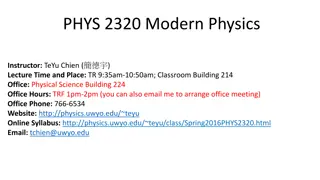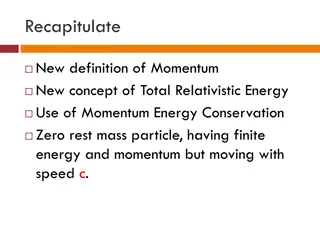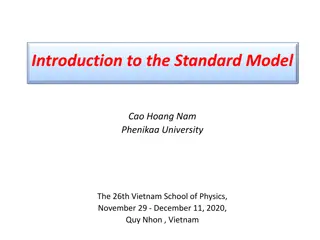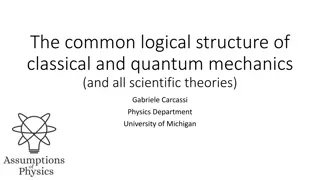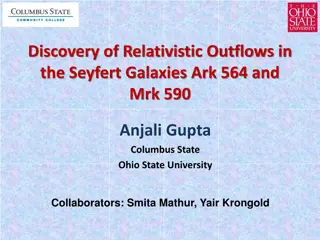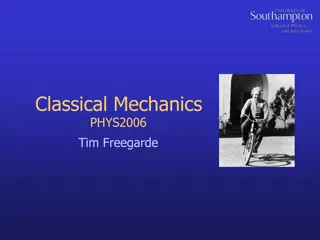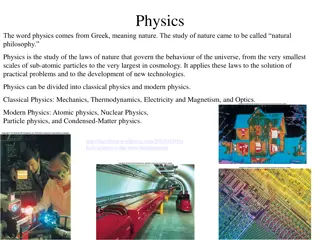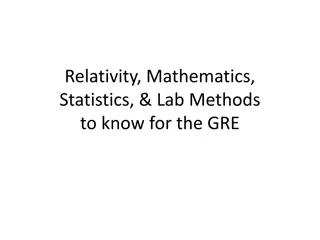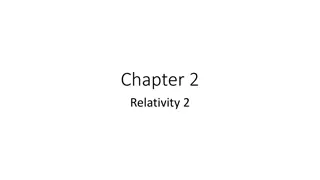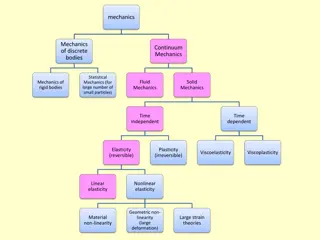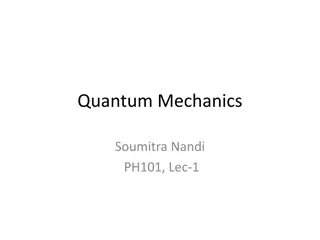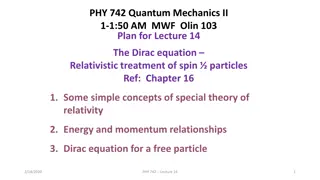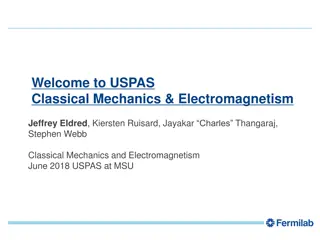Relativistic to Classical Mechanics Transition
The transition from relativistic to classical mechanics involves setting the speed of light equal to a specific value, affecting various formulas. Explore concepts such as signal velocity, inertial reference frames, event intervals, and causal relationships to understand the key principles in this transition. Delve into the conditions for events to occur at the same point in a reference frame and consider how light's speed and direction are consistent across different frames of reference.
Uploaded on Feb 16, 2025 | 0 Views
Download Presentation

Please find below an Image/Link to download the presentation.
The content on the website is provided AS IS for your information and personal use only. It may not be sold, licensed, or shared on other websites without obtaining consent from the author.If you encounter any issues during the download, it is possible that the publisher has removed the file from their server.
You are allowed to download the files provided on this website for personal or commercial use, subject to the condition that they are used lawfully. All files are the property of their respective owners.
The content on the website is provided AS IS for your information and personal use only. It may not be sold, licensed, or shared on other websites without obtaining consent from the author.
E N D
Presentation Transcript
The transition from relativistic to classical mechanics is effected in formulas by setting c equal to A. infinity B. 3 x 10^8 m/s C. 0
Which statement is not true? A. The signal velocity depends on the motion of the observer. B. All physical laws have the same form in all inertial reference systems. C. The maximum possible signal velocity is the same in all reference systems.
The interval between two events A. Is different in every inertial reference frame B. Might be the same or different, depending on which inertial frames are considered. C. The same in all inertial reference frames
The condition for two events to occur at the same point in some reference frame is that A. The interval between them is imaginary. B. The interval between them is real. C. The interval between them is zero.
The condition for two events to occur at the same point in some reference frame is that A. The interval between them is infinity. B. The interval between them is imaginary C. The interval between them is zero. D. The interval between them is real.
Events can be related causally if interval between them is A. Time like B. zero C. Space like D. infinity
Are vy and vz measured by an observer in K different from vy and vz measured by an observer in K , if the relative velocity V of K and K is along their aligned X and X axes? A. Yes B. No C. Depends on sign of V D. Sometimes
Light has the same speed in all frames of reference. Does it have the same direction? A. Always B. Not always
If we lower the index of a contravariant 4-vector, does the corresponding component change sign? A. No B. Sometimes C. Yes
What is ii? A. 1 B. 3 C. 0 D. 4
What is inversion of the 4D coordinate system? A. x,y,z change sign B. x goes to -x C. all 4 coordinates change sign D. The coordinates are rotated until z points down.
How many free indices does the tensor Aikli have? A. 4 B. 0 C. 2 D. 3
Which of these equations is a proper tensor equation? 1. Aiji=Bij 2. Aiji=Bj 3. Aiji=Bj 4. Aiji=Bk
A monoenergetic beam consists of unstable particles with total energies 100 times their rest energy. If the particles have rest mass m, their momentum is most nearly equal to... A. 100 mc B. mc C. 70 mc D. 10 mc E. 10000 mc
What effect acting alone causes no change in a particles kinetic energy? A. A time dependent vector potential B. A spatially varying vector potential C. A time dependent scalar potential D. A spatially varying scalar potential
Is it possible to have an electric field if the scalar potential is everywhere zero? A. Only under time reversal. B. No C. Yes D. Only in 3D.
Scaler potential and vector potential A are measured by an observer in inertial frame K at a point P. An observer in frame K' moving at V along the X,X' direction measures ' and A at the same point P. Which is true? A. = . B. ' is a linear combination of and Ax. C. Ax' is a linear combination of Ax, Ay, and Az.
If scalar and vector potentials are given A. the fields are determined only to within a constant B. electric and magnetic fields are uniquely determined. C. the fields are determined only to within the four- gradient of an arbitrary scalar function. D. Only the electric field is determined.
What is the shape of the trajectory for a relativistic charged particle in a constant uniform electric field? A. helix B. parabola C. hyperbola D. catenary
What is the shape of the trajectory of a relativistic charged particle in a constant uniform magnetic field? A. cycloid B. hyperbola C. adiabat D. helix
The electromagnetic field tensor is A. antisymmetric B. symmetric C. isotropic D. null
The electromagnetic field tensor has how many independent components A. 6 B. 12 C. 16 D. 4
For a reference frame K' moving at speed V relative to K along their mutual x-axis, how is E'x related to Ex? less than unchanged Inversely proportional greater than
What kind of vector is the electric field? A. axial B. null C. isotropic D. polar
If electric and magnetic field vectors are perpendicular in one inertial reference frame, they... A. are perpendicular in every inertial frame. B. form an acute angle in every other frame C. are parallel in some inertial frame D. may form an obtuse angle in some inertial frame.
If E>H in one reference frame, then... A. E can be zero in another reference frame B. E>H in every other inertial reference frame C. H can never be zero in any other reference frame D. E may be less than H in some reference frame
The combination of field tensor components given by FikFik is A. a pseudo scalar B. equal to 2E.H C. an invariant scalar D. equal to grad H.
Which is true? Under Lorentz transformations... A. charge density can be eliminated B. charge density is invariant C. charge density and current density transform into linear combinations of each other D. Current density is invariant
The continuity equation implies A. charge conservation and time-reversal symmetry B. Gauge invariance and inversion symmetry C. time reversal symmetry and gauge invariance D. charge conservation and gauge invariance
The total charge in the universe is found from A. an integral of charge density over all volume for any finite range of times B. an integral of charge density over all volume at a given time C. an integral of current density over all time D. an integral of charge density over all volume and all time
The units of energy flux density are A. energy/volume B. energy/(time*area) C. energy/(time*volume) D. energy/time
The magnetic field around a straight current-carrying wire can be found using A. Maxwell's law B. Faraday's law C. Ampere's law D. Gauss's theorem
The magnetic field depends on the radial distance r from a long straight current carrying wire according to A. 1/r B. ln(r) C. 1/r^2 D. Exp[-r]
The energy density of electromagnetic fields E and H goes as A. product of the fields B. linear in the field C. sum of their squares D. difference of their squares
T00 of the energy-momentum tensor is the... A. momentum flux density B. energy density C. momentum density D. energy flux density
T01/c is the... A. x-component of the electric field B. x-component of the energy flux density C. x-component of the momentum density D. x-component of the momentum flux density
For a particle at rest, the time component of the 4-velocity has the value... A. infinity B. 1 C. 0 D. c
The flux of the different components of the momentum vector in the different directions is given by the ... A. momentum density vector B. energy-momentum tensor C. energy density D. stress tensor
The electrostatic self-energy of an electron is ... A. infinity B. mc^2 C. 0 D. (1/2) mc^2
To an observer in the lab, the electric field distribution of a charge moving relativistically through the lab is... A. spherically symmetric B. elongated in the direction of motion C. flattened into a pancake perpendicular to the direction of motion. D. zero
Does a point charge have a dipole moment? A. Yes, if located at the origin. B. Yes, if not located at the origin. C. No, if not located at the origin. D. Never
A system comprises one positive point charge and one negative point charge separated by a finite distance. Does this system have any moments other than the dipole moment? A. Yes B. No C. Only a quadrupole moment D. Only a monopole moment
If current density is all in one direction, the vector potential is... A. zero B. perpendicular to that direction C. in the same direction D. infinity
Contributions to the vector potential at a given field point from different points in a current distribution... A. are equal for all distances between source and field points B. diminish as inverse square of distance between source and field points C. diminish as inverse distance between source and field points D. Increases linearly with distance between source and field points
The condition div A = 0 is called the... A. Feeler Gauge B. Lorentz Gauge C. Coulomb Gauge D. Landau Gauge
Any function f(t-x/c) is... A. not a plane wave unless f is a sinusoidal function B. a plane wave moving toward positive x. C. a standing wave D. a plane wave moving toward negative x
The general polarization of a monochromatic plane wave is A. unpolarized B. linear C. elliptical D. circular
If a light source is receding from an observer, she measures the wavelength of the light to be _______________ in comparison to the value if the source were at rest. A. unchanged B. shorter C. longer D. inverted






